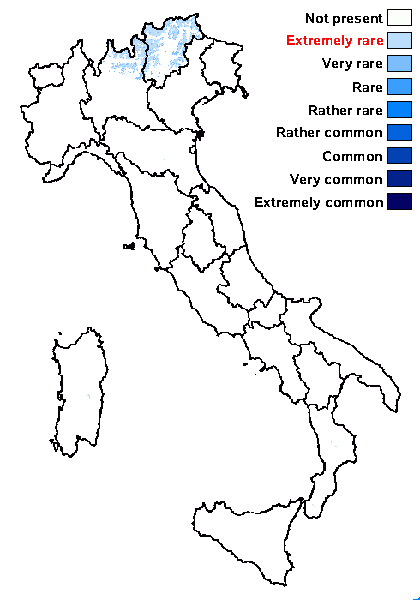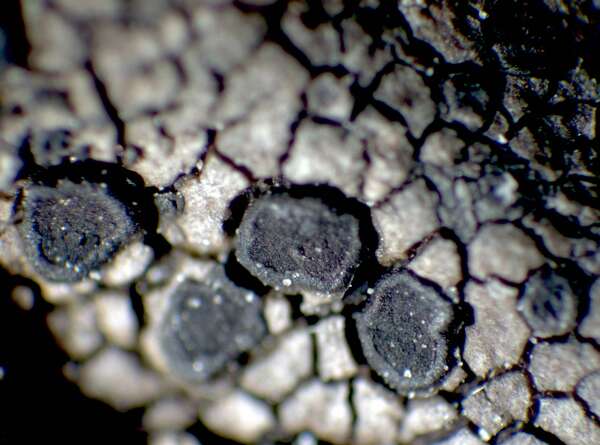Rinodina rinodinoides (Anzi) H. Mayrhofer & Scheid.
Nord. J. Bot., 12: 454, 1992. Basionym: Buellia rinodinoides Anzi - Atti Soc. Ital. Sc. Nat. Milano, 9: 253, 1866.
Synonyms: Lecidea rinodinoides (Anzi) Stizenb.; Rinodina melanocarpa Müll. Arg.; Rinodina serpentini H. Mayrhofer & Poelt
Distribution: N - TAA, Lomb (Giralt & Llimona 1997), Emil (Fariselli & al. 2020). C - Sar. S - Cal.
Description: Thallus crustose, episubstratic, to 0.5 mm thick, areolate, without a distinct prothallus, the areoles sharply angular, up to 1.4 mm wide, contiguous, flat, whitish to grey, rarely grey-brown, dull. Apothecia pseudolecanorine to lecideine, innate to adnate, 0.3-1 mm across, with a black, flat to slightly convex disc and a black, often sinuous proper margin. Proper exciple colourless, 10-15 µm wide laterally, up to 15-20 µm wide in upper part; epithecium reddish brown, K-; hymenium colourless, 80-90(-110) µm high; paraphyses 1.5-2 µm thick in lower part, conglutinate, the apical cells 3-3.5 µm wide, immersed in a dispersed pigment; hypothecium colourless to pale brown, 70-130(-180) µm high. Asci 8-spored, clavate, the K/I+ blue tholus penetrated by a faintly amyloid apical cushion with parallel or diverging flanks, the wall K/I-, surrounded by a K/I+ blue outer layer, Lecanora-type. Ascospores 1-septate, brown, ellipsoid, 13-18 x 7-11 µm, with rugulate-ornamented walls, Milvina-type, with ontogeny of type A (apical wall thickening after septum formation). Pycnidia dark, immersed in thallus. Conidia bacilliform, 5-6 µm long. Photobiont chlorococcoid. Spot tests: K-, C-, KC-, P-, UV-. Chemistry: zeorin. Note: an arctic-alpine species described from the Italian Alps and also known from the Karakorum Mountains, found on usually south-exposed surfaces of very hard, base-rich siliceous rocks and serpentine near and above treeline.
Growth form: Crustose
Substrata: rocks
Photobiont: green algae other than Trentepohlia
Reproductive strategy: mainly sexual
Commonnes-rarity: (info)
Alpine belt: extremely rare
Subalpine belt: very rare
Oromediterranean belt: extremely rare
Montane belt: absent
Submediterranean belt: absent
Padanian area: absent
Humid submediterranean belt: absent
Humid mediterranean belt: absent
Dry mediterranean belt: absent

Predictive model
Herbarium samples
Growth form: Crustose
Substrata: rocks
Photobiont: green algae other than Trentepohlia
Reproductive strategy: mainly sexual
Commonnes-rarity: (info)
Alpine belt: extremely rare
Subalpine belt: very rare
Oromediterranean belt: extremely rare
Montane belt: absent
Submediterranean belt: absent
Padanian area: absent
Humid submediterranean belt: absent
Humid mediterranean belt: absent
Dry mediterranean belt: absent

Predictive model
| Herbarium samples |
 INDEX FUNGORUM
INDEX FUNGORUM
 GBIF
GBIF
 DOLICHENS
DOLICHENS






